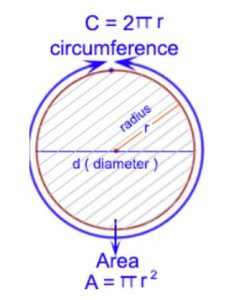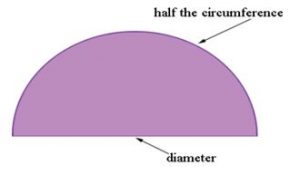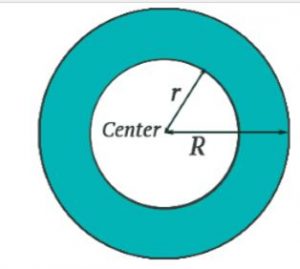Perimeter and Area of a Circle:
The perimeter of all the plain figures is the outer boundary of the figure. Likewise, the outer boundary of the circle is the perimeter of the circle. The perimeter of circle is also called the Circumference of the Circle.
Circumference = 2 π r = π d (π = 22/7 )
r = radius and d = 2r
The area is the region enclosed by the circumference.
Area of the circle = π r2
Example : If a pizza is cut in such a way that it divides into 8 equal parts as shown in the figure, then what is the area of each piece of the pizza? The radius of the circle shaped pizza is 7 cm.
Solution: The pizza is divided into 8 equal parts, so the area of each piece is equal.
Area of 1 piece = 1/8 of area of circle
= 1/8 × π r2
= 1/8 × 22/7 × 7 × 7
= 77/4 cm2
Perimeter and Area of the Semi-circle:
The perimeter of the semi-circle is half of the circumference of the given circle plus the length of diameter as the perimeter is the outer boundary of the figure.
Circumference of the semi-circle = 2π/2 +d = πr + 2r
Area of the semi-circle is just half of the area of the circle.
Area of the semi circle = (πr2)/2
Area of a Ring:
Area of the ring i.e. the coloured part in the above figure is calculated by subtracting the area of the inner circle from the area of the bigger circle.
Area of the ring = πR2 −πr2 = π (R2 −r2 )
Where, R = radius of outer circle
r = radius of inner circle
Exercise 12.1
1. The radii of two circles are 19 cm and 9 cm respectively. Find the radius of the circle which has a circumference equal to the sum of the circumferences of the two circles.
Solution: The radius of the 1st circle = 19 cm (given)
∴ Circumference of the 1st circle = 2 π × 19 = 38π cm
The radius of the 2nd circle = 9 cm (given)
∴ Circumference of the 2nd circle = 2π×9 = 18π cm
So, the sum of the circumference of two circles = 38π+18π = 56π cm
Now, let the radius of the 3rd circle = R
∴ The circumference of the 3rd circle = 2 π R
It is given that sum of the circumference of two circles = circumference of the 3rd circle
Hence, 56 π = 2 π R
Or, R = 28 cm.
2. The radii of two circles are 8 cm and 6 cm respectively. Find the radius of the circle having area equal to the sum of the areas of the two circles.
Solution: Radius of 1st circle = 8 cm (given)
∴ Area of 1st circle = π(8)2= 64π
Radius of 2nd circle = 6 cm (given)
∴ Area of 2nd circle = π(6)2 = 36π
So,The sum of 1st and 2nd circle will be = 64 π + 36 π = 100 π
Now, assume that the radius of 3rd circle = R
∴ Area of the circle 3rd circle = π(R)2
It is given that the area of the circle 3rd circle = Area of 1st circle + Area of 2nd circle
Or, π R2 = 100π cm2
R2 = 100cm2
So, R = 10cm
3. Fig. 12.3 depicts an archery target marked with its five scoring regions from the centre outwards as Gold, Red, Blue, Black and White. The diameter of the region representing Gold score is 21 cm and each of the other bands is 10.5 cm wide. Find the area of each of the five scoring regions.
Solution: The radius of 1st circle,r1 = 21/2 cm (as diameter D is given as 21 cm)
So, area of gold region = π r2 = π(10.5)2 = 346.5 cm2
Now, it is given that each of the other bands is 10.5 cm wide,
So, the radius of 2nd circle, r2 = 10.5cm+10.5cm = 21 cm
Thus, ∴ Area of red region = Area of 2nd circle − Area of gold region = (π r2 −346.5) cm2
= [π(21)2 −346.5] cm2
= 1386 − 346.5
= 1039.5 cm2
Similarly,
The radius of 3rd circle, r3 = 21 cm + 10.5 cm = 31.5 cm
The radius of 4th circle, r4 = 31.5 cm + 10.5 cm = 42 cm
The Radius of 5th circle, r5 = 42 cm + 10.5 cm = 52.5 cm
For the area of nth region,
A = Area of circle n – Area of circle ( n – 1)
∴ Area of blue region (n = 3) = Area of third circle – Area of second circle
= π(31.2)2– 1386 cm2
= 3118.5 – 1386 cm2
= 1732.5 cm2
∴ Area of black region (n = 4) = Area of fourth circle – Area of third circle
= π(42)2– 1386 cm2
= 5544 – 3118.5 cm2
= 2425.5 cm2
∴ Area of white region (n = 5) = Area of fifth circle – Area of fourth circle
= π(52.5)2– 5544 cm2
= 8662.5 – 5544 cm2
= 3118.5 cm2
4. The wheels of a car are of diameter 80 cm each. How many complete revolutions does each wheel make in 10 minutes when the car is travelling at a speed of 66 km per hour.
Solution: The radius of car’s wheel = 80/2 = 40 cm (as D = 80 cm)
So, the circumference of wheels = 2 π r = 80 π cm
Now, in one revolution, the distance covered = circumference of the wheel = 80 π cm
It is given that the distance covered by the car in 1 hr = 66km
Converting km into cm we get,
Distance covered by the car in 1hr = ( 66×105) cm
In 10 minutes, the distance covered will be = = (( 66 × 105×10))/60 = 1100000 cm/s
∴ Distance covered by car = 11 × 105 cm
Now, the no. of revolutions of the wheels = ((Distance covered by the car))/((Circumference of the wheels))
= ( 11 × 105 )/(80 π) = 4375.
5. Tick the correct Solution: in the following and justify your choice : If the perimeter and the area of a circle are numerically equal, then the radius of the circle is
(A) 2 units
(B) π units
(C) 4 units
(D) 7 units
Solution: Since the perimeter of the circle = area of the circle,
2πr = πr2
Or, r = 2
So, option (A) is correct i.e. the radius of the circle is 2 units.




